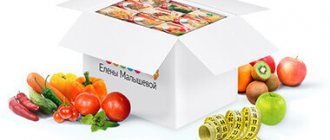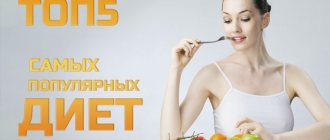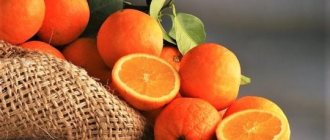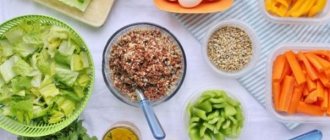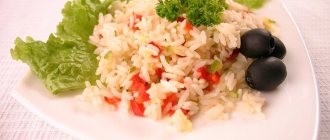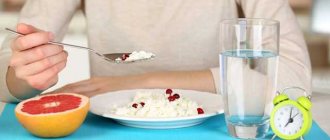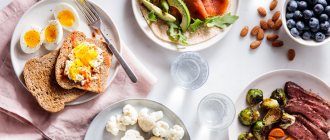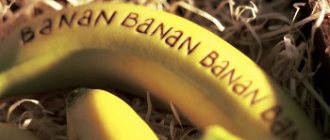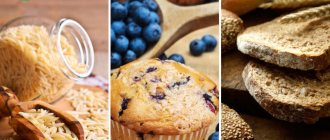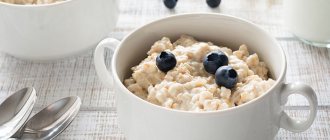On a gentle diet, there is no painful feeling of hunger, the body receives all the necessary nutrients, and the kilograms are easily lost. Choose one of 14 effective diets and remove excess fat from your waist and hips!
Author: Kristina Lobanovskaya, doctor, practicing nutritionist Article updated: 11/10/2020
Most weight loss diets are based on fairly strict restrictions. Compliance with them is associated with a feeling of hunger, against the background of which the so-called “dietary depression” develops. Along with rapid weight loss, the body suffers a powerful blow due to a deficiency of nutrients. As a result, internal organs cease to fully perform their functions, which leads to the development of a number of diseases. Beneficial programs are not so radical. They are aimed at gradual weight loss without negative effects on health.
Advantages
A gentle diet is a diet enriched with minerals and vitamins for relatively quick weight loss. With its help, it is possible to remove waste and toxins from the body that have accumulated for many years. The term “gentle diet” was first introduced into the lexicon by the Soviet therapist M.I. Pevzner, who is considered to be the founder of dietetics as a science.
Gentle nutrition systems for weight loss are unique in that they help the body get rid of extra pounds without forcing the body to go to extremes and starve.
A “soft” diet has many advantages:
- Cleanses the body of harmful accumulations.
- Consists of simple and affordable dishes.
- Does not provide for strict prohibitions.
- Does not put a strain on the digestive system.
- Provides a person with energy.
- Helps maintain weight in the long term.
The main advantage of a gentle nutrition program is the chance to switch to correct eating habits without much difficulty.
The daily energy value of such a diet is about 2250 kcal. Approximately 250 grams are allocated for carbohydrates, 90 grams for fats, and 85 grams per day for proteins.
Is a gentle diet applicable for diseases of the gastrointestinal tract?
Therapeutic diets are used to treat various diseases of the stomach, intestines or biliary tract. Gentle dietary nutrition is prescribed by doctors to stabilize the condition after surgery or during treatment of patients in a hospital. Despite the fact that this is also a type of gentle diet, a healthy person does not need to independently choose one of the options. Medical diets are specially designed for the gradual restoration of the functioning of the gastrointestinal tract and are not used for the purpose of losing weight. The general principles are similar - avoidance of fried, floury, spicy, fatty foods, minimal heat treatment of foods.
Rules
- Fractional meals. Food is taken little by little, 5-6 times a day.
- Drinking regime. Water in the amount of 1-1.5 liters is consumed between meals. You can't drink while eating!
- Healthy dishes. Products are prepared in the correct ways: stewing, boiling, baking, steaming.
- Food should be at room temperature.
- Refusal of spices. A little salt is allowed. Lemon juice, parsley and dill are used to improve the taste of dishes.
- Last meal 3 hours before bedtime.
When creating a diet menu, it is important to follow certain rules:
- Include protein in your diet, which maintains metabolic processes at the proper level and accelerates fat burning.
- Eat foods rich in iron.
- Don't give up complex carbohydrates.
- Regularly take vegetable oils that cleanse toxins (flaxseed, grape seed, olive, sesame).
The following products are prohibited:
- semi-finished products and sausages;
- smoked meats and canned food;
- rich pastries and fresh bread;
- fatty dairy and fermented milk products;
- coarse porridges (barley, pearl barley, millet);
- vermicelli;
- spinach and sorrel;
- radish and radish;
- chocolate and ice cream;
- pickled vegetables;
- fruits that are too sour;
- berries with hard grains;
- carbonated drinks and alcohol.
Recommended for use:
- dry biscuits, whole grain and rye bread;
- lean beef, chicken, turkey, rabbit;
- beef liver, tongue;
- eggs;
- lean fish;
- low-fat dairy and fermented milk products;
- hard mild cheese;
- green and herbal tea.
Recommendations for Beginners
A gentle nutritional system for weight loss is especially recommended for those who have ventured into dietary restrictions for the first time. This is a good start for further weight loss through more rigorous programs.
Before starting a diet, you should go through a preparatory stage, which consists of restoring water balance. You should drink at least two liters of water per day. The first glass is in the morning on an empty stomach, the rest – half an hour before meals.
To make your first experience successful, it is recommended to follow the rules of healthy weight loss:
- The diet should be enriched with the components necessary for the normal functioning of the body: microelements, proteins, carbohydrates, fats and vitamins.
- It is very important to control the caloric content of food: calorie intake should not exceed their expenditure.
- Dishes should be prepared with minimal loss of macro- and microelements.
Beginners should not follow a “soft” diet for more than a week and repeat the course in less than a month.
Packaged juices and alcohol, fatty and salty foods, various sauces and mayonnaise are completely excluded from the diet. It is recommended to replace sweets with a spoonful of fresh honey or dried fruits. Occasionally you can indulge in a piece of dark chocolate. Confectionery products are perfectly replaced with curd desserts. For greater benefits, you can add dried apricots or carrots. Sausages are strictly prohibited.
Natural coffee is allowed at the very beginning of acquaintance with a light diet, but only empty coffee - without milk, cream and sugar.
The nutrition system menu for beginners could be like this:
- Breakfast: buckwheat porridge with water, rye bread toast with a piece of low-fat cheese, unsweetened green tea.
- Snack: fresh apple.
- Lunch: light soup, a piece of boiled beef, cucumber salad with herbs.
- Afternoon snack: orange.
- Dinner: casserole of low-fat grainy cottage cheese, herbal decoction.
Taking a vitamin-mineral complex will help support the body, which is faced with an unusual way of eating.
Nutrition after intestinal surgery: basic principles and rules - Stomach
Nutritional therapy is a key stage of rehabilitation after intestinal surgery. Following a diet after surgery reduces the incidence of complications and speeds up the patient’s recovery.
Important Diet Aspects
- Nutrition should be gentle. Eating food should not provoke an exacerbation of the pathology of the digestive tract.
- The diet should help normalize metabolism.
- Nutrition must fully meet a person’s needs for proteins, fats, carbohydrates, vitamins and minerals, taking into account age, chronic pathology and other factors.
- Therapeutic nutrition should increase the body's resistance to infectious diseases.
- The diet should promote rapid healing of the surgical wound.
- The diet should not remain strict for more than the prescribed time. In the absence of complications, it is recommended to switch to a nutritious diet as early as possible.
The main emphasis of the therapeutic diet is set while still in the hospital.
After discharge, the patient receives recommendations for further nutrition. It is important to strictly follow the instructions given. Errors in nutrition lead to the development of complications.
Do you have intestinal diseases? — Take the online test!
Principles of nutrition
- Frequent small meals. It is recommended to eat 5-6 times a day in small portions.
- Drinking regime. If there are no contraindications, you need to drink 1.5-2 liters of fluid per day. Drinking enough water normalizes intestinal function and improves peristalsis. With pathologies of the heart and kidneys, the volume of fluid is limited.
- Food should be light, but nutritious, balanced in proteins, fats and carbohydrates.
- Light snacks are possible between main meals.
- Fasting is not allowed. You can't skip meals. If you can’t eat on time, you need to have a light snack or drink a high-calorie drink.
- You should not have a snack half an hour before your main meal.
- It is not recommended to drink high-calorie drinks 30-60 minutes before meals - they create a false feeling of fullness.
- Food should be steamed or baked in the oven. You should avoid fried foods.
- Products that have undergone mechanical processing will be beneficial: ground, pureed, crushed.
- Protein-rich foods should be mixed with vegetable dishes to meet the body's needs for nutrients and vitamins.
- Very hot and cold dishes are excluded.
- The amount of salt is limited.
- New products are introduced into the main diet gradually - once a week. For 3-5 days you need to observe the sensations that arise after eating. If there is a negative reaction to a new product (abdominal pain, stool loss, flatulence, heartburn), it should be temporarily excluded from the diet. You can repeat the experiment after 2-4 weeks. Good tolerance of new dishes indicates restoration of the intestines and allows you to expand your diet.
- If postoperative lactase deficiency develops, it is necessary to avoid drinking whole milk for a long time or permanently.
A gentle version of the Dukan technique
The system of the French nutritionist Dukan is considered one of the most effective for safe weight loss. Its lightweight version, called the “Nutrition Ladder,” is an idea for those who cannot handle the classic program with all its restrictions and rules. The diet is balanced.
It’s not for nothing that the method is called a “ladder”: a week on it is divided into 7 steps, each of which means 1 day. Every day the range of products approved for consumption is expanding. Dukan recommends sticking to the system until the optimal body weight figure is finally achieved.
Required conditions:
- 1.5-2 liters of water per day.
- Consumption of oat bran in the amount of 1.5-2 tablespoons.
- Walking for 30 minutes.
Meals by day:
- 1st – protein. It is allowed to eat fish, lean meat, low-fat dairy products, and eggs.
- 2nd – proteins + vegetables. Starches and legumes are prohibited.
- 3rd – proteins + vegetables + fruits. Grapes and bananas are prohibited.
- 4th – proteins + vegetables + fruits + whole grain bread (a couple of pieces per day).
- 5th – several slices of cheese are added to the diet.
- 6th – the diet may include starchy foods: rice, pasta, potatoes in an amount of 200 grams.
- 7th – food can be varied, tailored to your own preferences. It is acceptable to drink a glass of dry red wine and eat a full meal of several courses.
Weight loss with simple nutrition is about 1 kilogram per week. Losing weight looks comfortable, so the technique is suitable for nursing women, teenagers and older people.
The correct way out of the diet involves gradually eliminating days with the most limited diet. This same moment acts as a reinforcement, preventing the lost weight from returning again. During the first week, after the end of the event, the protein-vegetable day should be excluded.
Read more: Dukan Diet
Ducan's diet
This is a unique and effective weight loss method developed by nutritionist Pierre Dukan.
The essence of this effective diet can be briefly described in the words of the author himself: “Eat and lose weight,” since the food on such a diet is satisfying, but at the same time low in calories. The research that resulted in this weight loss technique was carried out over 40 years. Despite the fact that the diet is over 30 years old, it gained popularity about a dozen years ago, after a doctor’s book entitled “I Can’t Lose Weight” was published in 2000, where he describes the basic principles of nutrition and low-calorie recipes . This diet is recognized as one of the most effective in the world. Description and rules
- The main stages for the fastest and most significant weight loss.
- Recording progress achieved and preventing weight gain.
Each stage involves eating certain foods and lasts a specific amount of time, which is selected individually for each.
Stage 1
The Attack stage is the starting stage of a gentle diet, which serves to cleanse and prepare the body for weight loss.
It should last taking into account the number of extra pounds that a person intends to lose, but no more than 10 days. If you plan to get rid of 18 kg, then it will take 5 days, if from 30 kg, then 10 days. During this stage, a restructuring of the entire body occurs. In 10 days at this stage you can quickly lose up to 7 kg of fat mass - it is considered the most effective. During the first phase, you can consume more than 50 protein-containing foods in boiled, baked, stewed and fried form and in unlimited quantities. Important!
To get the maximum result from one of the most effective diets, you need to strictly follow all the rules and not eat foods not included in the diet.
If a “breakdown” does occur, you need to continue the diet, making up for the missed day. Stage 2
The main and longest stage of weight loss, which is called “alternation”.
The essence of nutrition is alternating purely protein and vegetable days. Moreover, the alternation can be chosen at your discretion, for example, 1 day of protein and 1 vegetable or 3 days of protein and 2 vegetable days, etc. You need to stick to this diet until the goal is achieved. The alternating phase usually lasts from 2 to 6 months, during which you can lose from 10 to 30 kg. The essence of such nutrition is to exclude harmful foods and saturate the body with amino acids and vitamins. Stage 3
The consolidation stage is accompanied by continued adherence to a gentle and effective diet, by eating vegetable and protein dishes, but also adding other carbohydrate-containing foods, such as healthy sweets and desserts.
Thanks to such a smooth exit from the diet and the gradual inclusion of a variety of foods in the diet, you don’t have to be afraid of regaining lost kilograms. The main thing at the third stage is patience, because for every kg lost there are 10 days of consolidation. Thus, if someone losing weight has lost 10 kg, then the “recovery” will last 100 days, and this is quite a long period during which weight loss will still continue. Stage 4
At the stage of stabilizing an effective diet, you can already return to normal nutrition, but you must follow a number of rules that it is advisable to adhere to throughout your life.
What to do daily:
- drink clean water (from 1.5 l);
- be constantly on the move: walk more often, climb stairs, etc.;
- play sports (yoga, Pilates, swimming, running, etc.);
- eat 3 tbsp. l. bran.
Attention!
The author of the diet advises doing fasting days from time to time during the stabilization stage in order to keep your weight normal throughout your life.
Permitted and prohibited products
The following will be a sample list of products on one of the most effective diets.
What is allowed to eat during the attack phase:
- Meat (turkey, beef, chicken, veal ham). Only duck and goose are prohibited.
- Dairy products (low-fat fermented baked milk, yogurt, kefir, cottage cheese, milk).
- Fish (any fresh fish products and seafood, a small amount of crab sticks and smoked meats, canned food without oil).
- Bird eggs (whites - can be consumed in any quantity, and yolks - in a minimum amount).
- Various additives: soy sauce, tomato paste, garlic, dill, parsley, cilantro, red, white and yellow onions, flax seed, olive oil (1 tbsp.).
- Additional products - tofu, seitan, goji berries, shirataki noodles.
- Oat bran - 1.5 tbsp. l per day.
At stage 2 of an effective diet for weight loss, vegetables are added to the list of allowed foods:
- Any vegetables and greens in any quantity, except potatoes, sweet potatoes, avocados, corn, as well as any legumes such as beans, lentils and peas.
- The amount of oat bran increases to 2 tablespoons.
Starting from stage 3, the following products can be introduced:
- Rye and whole grain bread - no more than 50 g per day.
- Low-fat cheese (up to 20%) - up to 40 g per day.
- Any fruit, except the most high-calorie ones - up to 200 g daily.
- Products with starch, such as legumes, rice, potatoes, pasta, are allowed on a gentle diet once a week, 200 grams, after some time this can be increased to 2 rubles per week.
- Buckwheat - up to 200 g daily.
- Ham, bacon, pork, lamb - 1-2 times a week.
- Unhealthy dishes, such as cake or high-calorie salad - a small amount once a week, at the end of the stage can be increased up to 2 times.
- Oat bran - 2.5 tbsp. l. daily.
At stage 4, you can return to your normal diet, but try to choose lean meat, dairy and fish products, eat small portions, drink more water and consume 3 tablespoons of bran daily.
Important!
Remember that for successful weight loss you need to cook all dishes without oil, reduce salt intake if possible, and also exercise every day.
Modes for fast weight loss
The gentle diets presented below are suitable even for beginners.
Fractional
The most gentle way for the body is weight loss based on the principles of fractional nutrition. Food should be taken often, but little by little. This will avoid even a hint of hunger. The diet can last from 5 to 10 days. At this time, it is important to completely eliminate flour, sweets and alcohol.
An approximate diet is:
- 8:00 – herbal decoction without sugar (in the first two days you can add a little fresh honey).
- 10:00 – carrot-apple salad with lemon juice.
- 12:00 – plum or peach.
- 14:00 – a portion of boiled fish, a slice of rye bread.
- 16:00 – a piece of low-fat cheese.
- 18:00 – salad of boiled carrots and beets with a small amount of flaxseed oil.
- 20:00 – 8 pieces of dried apricots.
- 22:00 – a glass of skim milk or kefir.
You are allowed to drink plain water during the day. Several times a day you can use rosehip decoction (if there are no problems with the kidneys).
Read more: Fractional diet
Hypocarb
The success of a no-carb diet for weight loss is based on consuming only fats and proteins. Following the program is not difficult, but the body is still harmed. A gentle version of the system, defined as hypocarbohydrate, does not imply the complete elimination of carbohydrates, but a reduction in the volume of their intake to a minimum.
Allowed for use:
- dairy products;
- porridge;
- fruits;
- vegetables;
- chicken meat without skin.
Among the especially recommended vegetables are eggplants, cabbage, and cucumbers. As for fruits, it is advisable to eat kiwi, plums, peaches, apples and citrus fruits.
You will have to eat in small portions. All products containing flour should be removed from the diet:
- bread;
- buns;
- pasta;
- cookie.
You need to drink at least 1.5 liters of water per day. Before 12 noon you are allowed to eat a slice of dark chocolate.
Important! It is not recommended to “sit” on a hypocarbohydrate diet for more than seven days; it can harm the liver and kidneys.
Sample menu for one day:
- Breakfast: low-fat cottage cheese with the addition of sour cream and dried fruits (dried apricots, raisins, prunes), tea or coffee.
- Lunch: a piece of dark chocolate or a dessert spoon of fresh honey.
- Lunch: vegetable soup, lean porridge, vegetable salad with vegetable oil.
- Afternoon snack: muesli with milk, apple.
- Dinner: vegetable stew, a piece of boiled chicken, tea.
Vitamin and protein
A nutrition system based on the consumption of protein foods is popular all over the world. Its essence is to exclude fats and carbohydrates from the menu. A diet can be an unbearable burden for an organism unprepared for such tests. In this case, it makes sense to stick to its lighter version - a tasty and healthy vitamin and protein one.
A gentle vitamin-protein diet is an effective way to get rid of fat deposits and increase body elasticity.
Throughout the course, the menu is shown to include only those products that contain vitamins and protein. The approximate menu for day 1 is as follows:
- Breakfast: unsweetened coffee or herbal infusion, orange.
- Lunch: a couple of slices of hard cheese, fruit and vegetable juice.
- Lunch: a portion of boiled chicken breast, boiled egg, tea.
- Afternoon snack: unsweetened tea with crackers, apple.
- Dinner: vegetable salad with vegetable oil and quail egg, boiled meat, kiwi.
- Before bed: herbal tea.
On salads
Salad diets are considered one of the most budget-friendly and have a positive effect on the condition of the entire body. This is due to the high content of vegetables and herbs in the diet, rich in vitamins, fiber and minerals. Mono diets on salads last three days, while you can stick to softer ones for much longer.
In addition to salads, the menu contains protein products. In a week you can lose up to 5 kg of weight.
Menu for the week (standard salad serving size is 200 grams):
- Monday – “Whirl” salad (5 servings), 400 ml of kefir, a glass of tomato juice.
Preparing the salad: chop 300 g of white cabbage, grate 300 g of beets and 200 g of carrots, chop 50 g of greens. Mix, add a little vegetable oil and lemon juice.
- Tuesday – Greek salad (5 servings), 300 g of boiled chicken without fat, 400 ml of kefir, 200 ml of tomato juice.
Preparation: 350 g of cucumbers and tomatoes, chop 200 g of cheese into cubes, cut 250 g of bell pepper into strips, cut 1 head of Yalta onion into half rings, chop the parsley. Mix the ingredients, add the olives cut into rings. Pour in vegetable oil and pepper.
- Wednesday – “Fat Burning” salad (4 servings of 300 grams), 2 boiled eggs, 500 ml of kefir.
Preparation: chop 300 g of parsnips and celery root into strips, cut 200 g of bell pepper and cucumber into slices, chop 50 g of green onion and parsley. Mix, season with low-fat yogurt.
- Thursday – Green salad (4 servings), 1 boiled egg, 70 grams of seafood, 400 ml of tomato juice.
Preparation: finely chop 400 g of lettuce, chop 200 g of tomatoes and cucumbers coarsely, cut 200 g of bell pepper into strips, finely chop parsley, green onions and dill. Mix, sprinkle with olive oil and lemon juice.
- Friday – Tuesday menu. Fish is used instead of chicken.
- Saturday – Monday menu.
- Sunday – Wednesday menu + 200 grams of buckwheat.
Diet 6 petals
This gentle weight loss diet lasts 6 days, in which the menu is thought out very carefully, resulting in rapid weight loss without the feeling of hunger.
On this diet you can lose up to 5 extra kg. This method was founded by Swedish nutritionist Anna Johansson. In support of this express diet, we can say that it is officially recognized by the European Association of Dietetics. Description and rules
The basis of this mono-diet is the principles of separate nutrition, where it is assumed that certain foods are consumed every day in strict sequence. Proteins alternating with carbohydrates saturate the body and promote accelerated fat burning. This principle of nutrition can be confidently called a gentle and effective diet, since it is easily tolerated and the body does not enter a state of stress. At the same time, the body receives all the nutrients and microelements necessary for life.
Attention!
To motivate yourself during the week, you can draw and cut out a daisy, writing or drawing the food menu for each day on the petals. As you progress, the petals come off, allowing you to visually monitor your progress and success.
As already mentioned, this gentle diet for weight loss is divided into 6 days, on each of which you need to eat a certain type of product:
- day - fish (protein). The body is saturated with proteins and Omega-3 fatty acids, which are beneficial for the cardiovascular and nervous systems, hair and nails. In addition to a significant plumb, the first day is also preparatory for the subsequent vegetable mono-day.
- day - vegetable (carbohydrate). Everyone knows how beneficial vegetables are for the body. Along with the low caloric content of the diet, the body receives a considerable amount of dietary fiber and cellulose, which help normalize the functioning of the gastrointestinal tract and also provide an easy cleansing of the body. Due to the fact that vegetables require large amounts of energy from the body to digest, the process of losing weight will happen much faster. There are even foods with “negative” calories, such as white cabbage. Vegetables on the vegetable day of a gentle diet are best eaten fresh or steamed.
- day - chicken (protein). Chicken meat is a dietary product containing a large amount of amino acids and vitamins. A day of such nutrition will help replenish protein reserves in the body. At the same time, tender chicken is a fairly satisfying product that will not allow hunger to develop.
- day - cereal (carbohydrate). You can eat healthy cereal porridges, as well as a small amount of whole grain bread. Particular preference is given to buckwheat porridge, which it is advisable not to boil, but to fill with hot water overnight. Hard cereal shells improve intestinal motility and also require additional energy expenditure for their digestion.
- day - cottage cheese (protein). On day 5, the gentle diet menu is limited to the consumption of natural cottage cheese, and it is better to choose a low-fat and as natural product as possible, without foreign impurities. Cottage cheese has a positive effect on the digestive system, enriches the body with calcium, vitamins and minerals. It keeps you feeling full for a long time, and it is even recommended to eat it at night.
- day - fruit (carbohydrate). Fruits filled with complex carbohydrates and glucose will provide the body with energy and further cleanse the intestines. At the same time, the process of losing weight continues due to the low calorie content of food, the exclusion of harmful foods and the expenditure of energy on the breakdown of polysaccharides.
Allowed and prohibited foods
Here is what you are allowed to eat day by day on the effective “6 petals” diet:
- Fish. You can eat any type of fish, be it cod or trout. But you need to cook it without fat. Dishes can be salted and spices and herbs added to taste. You can also eat fish broths.
- Vegetables. It is allowed to eat absolutely any vegetables in any form, but preferably fresh or minimally processed (steamed). A great option would be to drink vegetable smoothies.
- Chicken. Preferably skinless chicken breast, steamed, boiled or baked. Just as in the case of fish, dishes can be salted, peppered, and broths can be prepared.
- Cereals. Buckwheat, barley, millet, millet, oatmeal, pearl barley, couscous, semolina, bulgur, rice, bran, sprouts. Also, on an effective diet, you are allowed to eat a little rye, bran or whole grain bread and kvass.
- Cottage cheese. Advantage: natural 5% cottage cheese. You can also drink a little low-fat kefir or milk.
- Fruits. Apples, kiwi, pineapples, peaches, pears, oranges, grapefruits, plums, pomelo, mango, melon, watermelon, blueberries, blueberries, blackberries, strawberries, currants, lemon, apricot, cranberries, etc. Eating bananas and grapes is also not prohibited, but a little. It is advisable to eat fruits in their pure form. You can prepare various salads, smoothies and compotes from them.
- Beverages. Also, on all days of the mono-diet you need to drink at least 1.5 liters of clean water. You are allowed to drink a cup of coffee, as well as teas and infusions in any quantity.
The main ban applies to sugar, oil, fats, alcohol, flour products, canned food and semi-finished products.
Menu for the week
The diet while eating on the gentle “six petals” diet is quite meager, but the daily menu can be diversified by preparing foods in different ways. Below is the diet menu by day. Fig.2
“Soft” options for mono-diets
Buckwheat, kefir and rice diets top the TOP of effective mono-diet for weight loss. They are distinguished by their rigidity and short duration (no more than 3 days). Gentle versions of such diets are easier to tolerate: in addition to the main product, additional dishes and drinks are allowed into the diet. You can “sit” on them for 7 days, and if necessary, repeat after 1-1.5 months.
Buckwheat
The buckwheat porridge diet remains one of the most effective for weight loss. It is recommended by nutritionists as the safest way to lose weight. Buckwheat has long been called a healing product that saturates the body with useful substances and energy.
A gentle version of the buckwheat system is designed for a week. The main rule is the ban on eating fatty meat. You need to prepare the porridge in a special way - not boil it, but steam it. To do this, pour boiling water over buckwheat in a ratio of 1:1.5 and let stand for 2-3 minutes. Afterwards, drain the water and pour boiling water over the porridge again. They let it brew overnight and start using it the next morning.
A sample menu for one day looks like this:
- Breakfast: a portion of buckwheat porridge, 120 grams of low-fat cottage cheese, a glass of yogurt, a slice of hard cheese, tea.
- Lunch: green vegetable salad, a piece of boiled veal, mineral water.
- Afternoon snack: a portion of low-fat cottage cheese, a green apple.
- Dinner: buckwheat and vegetables with soy sauce, herbal decoction.
The diet allows you to lose weight without feeling an acute feeling of hunger, saturates the body with vitamins and protein. After which the achieved weight will be maintained.
Buckwheat and kefir
A simpler version of a gentle buckwheat diet involves introducing kefir into the diet. The program is designed for a week. The first four days are considered limited in the amount of food consumed.
1-4 days
- Breakfast: a portion of buckwheat, a glass of low-fat kefir.
- Lunch: a glass of fermented milk drink.
- Lunch: a portion of buckwheat porridge, low-fat yogurt.
- Dinner: a portion of porridge, a glass of kefir.
5-6 days
- Breakfast: a portion of buckwheat, green tea without sugar, crackers.
- Lunch: an apple or half an orange, low-fat yogurt.
- Lunch: a portion of buckwheat porridge, a tomato, a glass of fermented milk drink.
- Snack: vegetable salad.
- Dinner: a portion of buckwheat, a glass of fermented milk drink.
The seventh day diet consists only of porridge (200 g) and 1% fat kefir (1 liter), which are divided into 4 doses. In addition, per day you need to drink at least 2 liters of purified water, to which you can sometimes add a spoonful of fresh honey or a slice of lemon.
Read more: Buckwheat diet
Kefir
A healthy fermented milk product is actively used in almost all nutrition systems for weight loss. Kefir normalizes the functioning of the nervous and cardiovascular systems, helps improve intestinal functionality, and is indispensable for respiratory diseases.
The benefits of kefir for weight loss are obvious:
- low calorie;
- contains beneficial bacteria;
- rich in protein.
Can kefir be considered the main product during gentle unloading? Undoubtedly. This lasts 7 days. You will eat according to this scheme (all foods are divided into equal quantities and consumed 4 times):
- Monday: 1.5 liters of low-fat kefir, five boiled potatoes in their jackets.
- Tuesday: 1.5 liters of low-fat fermented milk drink, a portion of boiled chicken, tomato.
- Wednesday: 1.5 liters of low-fat fermented milk product, a portion of boiled veal.
- Thursday: 1.5 liters of low-fat fermented milk product, 150 grams of stewed fish, vegetables.
- Friday: 1.5 liters of kefir, fruits and vegetables.
- Saturday: 2 liters of kefir, dried fruits.
- Sunday: fasting day on still mineral water.
While observing gentle unloading on kefir, it is advisable to use a vitamin-mineral complex.
Read more: Kefir diet
Rice
The staple of Asian cuisine is often used in domestic diets for weight loss. Rice is good for the gastrointestinal tract and gives a feeling of fullness. To achieve weight loss effects, it is recommended to choose brown rice. It is considered the most useful because it quickly removes toxins and normalizes the functioning of the digestive system. If you can’t find such rice, you can choose long-grain white rice.
Unlike the strict rice mono-diet, the gentle one allows you to include other products in the menu: dairy, vegetables and fruits, protein. Simple, at first glance, food does not look bland, so the diet is easily tolerated. For 7 days the following menu is recommended:
- Breakfast: lean rice porridge, dried fruit compote.
- Snack: choice of fruit.
- Lunch: rice, 100 grams of stewed meat, tomato or cucumber.
- Afternoon snack: rice porridge, a glass of natural yoghurt with berries.
- Dinner: rice, baked vegetables, fermented milk drink.
Important! It should be remembered that a gentle rice diet is undesirable if you have frequent constipation and insulin instability.
Read more: Rice diet
How to create a gentle menu for the week
Healthy people who do not have any special indications for following a specific program should first of all pay attention to a balanced diet. The body must receive the required quantities of proteins, fats, and carbohydrates. Otherwise, any restrictions will lead to unpleasant consequences in the form of an eating disorder and weight gain.
An example of a one-day menu for a gentle diet for a week:
- breakfast - soft-boiled egg, porridge with milk without sugar, weak tea or chicory drink;
- lunch – baked unsweetened apple, glass of juice;
- lunch - soup with broth made from vegetables or lean meat, whole grain bread, freshly squeezed juice with pulp;
- afternoon snack – a glass of low-fat kefir with unsweetened fruit or 100 g of cottage cheese;
- dinner - steamed fish with a side dish of vegetables, tea with milk.
Fasting during a bland diet is strictly contraindicated, but you need to eat small portions every 4-5 hours to avoid feelings of acute hunger. The first meal should take place within an hour of waking up in order to “start” the metabolism. Before going to bed, you are allowed to drink a glass of milk or juice diluted with water.
The most gentle diet for losing belly fat
Many nutritional methods for losing weight in the abdomen and other problem areas (hips, legs) provide for frankly strict restrictions. Basically, these are mono-diets that call for eating a specific product every day. The diet should be supplemented with special exercises. The fat-burning effect manifests itself quickly, as do problems in the gastrointestinal tract.
Smooth correction of problem areas works differently - it does not hit the nerves and does not harm well-being. This does not affect the result in any way: fat deposits do not melt in a day, but they certainly go away.
The first step on the path to a toned stomach is cleansing the intestines. It will speed up weight loss in the future. Cleansing products:
- whole grains: millet, buckwheat, barley, oatmeal;
- vegetables (especially beets and carrots);
- fruits (especially green apples and pineapple) and dried fruits;
- legumes (beans, peas).
The best comrades in the matter of cleansing the intestines are natural prebiotics: chicory, sauerkraut, fermented milk products and kombucha.
The listed products should be on the menu for a week, after which you can move on to the diet itself. Her menu is based on the well-known principles of healthy weight loss and includes:
- lean meat and fish in the amount of 150 g. per day;
- several eggs in any form (except fried);
- bakery products made from wholemeal flour;
- low-fat fermented milk products (exclude hard cheese);
- fruits and raw vegetables;
- legumes and cereals.
Based on the permitted products, you should create a balanced and satisfying menu, divided into 5 meals. Use of other products is strictly prohibited! The drinking regimen is based on drinking 1.5 liters of pure water and compote without sugar, diluted with water 1:1.
A sample menu for several days might look like this:
1st
- Breakfast: a slice of bread, fresh tomato, low-fat yogurt, apple.
- Lunch: boiled egg, freshly squeezed juice.
- Lunch: a portion of boiled meat, vegetable broth, fresh cucumber, wholemeal bun.
- Afternoon snack: toast with a portion of boiled beans.
- Dinner: baked tomatoes, toast, buckwheat, tea with a spoon of honey.
2nd
- Breakfast: boiled egg, a few slices of bread.
- Lunch: apple.
- Lunch: rice, fresh tomato, slice of bread, yogurt.
- Afternoon snack: a slice of melon.
- Dinner: half a serving of stewed vegetables, a piece of baked fish, kefir.
A little about the importance of diet
Violation of the doctor's instructions may cause a deterioration in the patient's condition. Bleeding in the abdominal cavity, intestinal obstruction, polyps and tumors of varying degrees may develop. High risk of disease relapse.
The immune system is weakened during this period and needs additional vitamins and minerals to maintain strength.
Therefore, it is important to follow a proper diet after intestinal surgery for recovery. This healthy eating habit will promote healing and speedy recovery.
Healthy foods for the intestines
After intestinal surgery, the following products are allowed:
- gruel;
- cottage cheese with 0% fat content;
- low-fat cheese;
- blueberries, vegetables and fruits;
- grain flour;
- bran;
- crackers;
- flax-seed;
- boiled potatoes;
- still mineral water;
- compotes, jelly;
- vegetable juices;
- weak tea and coffee;
- butter (in small quantities for patients with adhesive disease);
- kefir (fermented milk products are not allowed if you have a stomach ulcer).
Causes fermentation, adhesions and even peritonitis and the following foods are not suitable for eating:
- cakes and wheat bran;
- spicy, salty, smoked, fried and pickled foods;
- meat, mushroom and fish soups;
- cabbage in any composition;
- beans, mushrooms, tomatoes, asparagus;
- sour (vitamin C) fruits and berries;
- canned food;
- cold and carbonated drinks;
- nuts;
- alcohol.
Prohibited Products
A proper diet after surgery on the gastrointestinal tract involves avoiding harmful foods, which include:
- Legumes, mushrooms and nuts. This product triggers the development of peritonitis.
- Cabbage and cauliflower, kohlrabi.
- Grapes, sour apples, pears and citrus fruits.
- Products are made from yeast.
- Sweet and flour products.
- Soda.
- Alcohol.
The dietary diet for patients prohibits the consumption of fried, salty, spicy, and smoked foods. Also, you cannot use different sauces and spices for cooking and seasoning.
How foods affect intestinal motility.
Important information! During rehabilitation, the beneficial effect of coffee. However, before you start drinking it, you must get permission from your doctor.
The essence of the diet is to regulate the patient’s stool, peristalsis and relieve pain in the intestines. A properly formulated diet does not burden the gastrointestinal tract, resulting in faster tissue restoration. The rehabilitation period lasts less.
Heat treatment rules
Products on the approved list must be treated accordingly. Of the existing methods, boiling and poaching are allowed.
Poaching is a change in cooking time that makes it possible to preserve the beneficial properties of food. 1/3 of the product is placed in hot water, the remaining 2/3 is boiled under steam, pressing the lid tightly. Juicy vegetables and fruits are simmered without the use of liquids. They languish in their own juice, which is formed when heated.
Heat treatment promotes high-quality absorption and destruction of harmful microorganisms. Improper preparation of dietary food leads to the formation of substances that have a carcinogenic effect.
Avoid high temperatures: 100°C is optimal. For vegetables, it is recommended to use temperatures below 60°C, otherwise vitamin C will be destroyed.
Steaming is the leading treatment method for dieting. To do this, you need to use a steamer with a well-fitting lid. Place a grate at the bottom of the container to load food and pour a small amount of water. During cooking, the cookware is filled with steam, which retains the shape and structure of the food. Ready-made dishes are juicy and do not lose elements beneficial to the body.
To make dishes as nutritious as possible, you need to steam them.
The first stage of the diet and menu
After the operation, until the person comes out of anesthesia, he is indicated to starve. If you are very thirsty, you can only moisten your lips with water. Of course, the patient is not completely deprived of nutrients because the body needs to recover after surgery. Only all necessary substances are administered to the patient parenterally, that is, through intravenous fluids.
On the second day, the patient is prescribed therapeutic diet No. 0a, which must be maintained until the fifth postoperative day. The main diet No. 0a is liquid food necessary for mechanical bowel movement.
The patient is allowed to drink rosehip decoction, non-rich broth, and rice water. You can also prepare liquid and semi-liquid dishes from sour berries: all kinds of compotes, jelly, jelly.
You need to eat in small portions, but regularly 7-8 times a day. Diet No. 0a is low-calorie and therefore is not able to satisfy all the body's energy needs. That is why extended parenteral nutrition is also prescribed during this period.
The second stage of the diet and menu
On the fifth day of the postoperative period, the patient was switched to surgical diet No. 1a. Eat according to the rules of this diet, the patient will have a period of six weeks. The basis of the diet is semi-liquid, pureed food. You need to eat six times a day, the volume portion at a time is no more than 400 grams.
This therapeutic diet is called physiologically complete. That is, surgical diet No. 1a contains enough calories, and nutrition according to this scheme fully provides the body with the necessary nutrients.
What foods can be consumed at this stage of the postoperative period?
- Liquid porridge puree;
- Cereal soups with vegetable broth;
- Hateful meat broths;
- Egg dishes: steamed eggs, soft-boiled eggs;
- Lean meat and fish cooked in steam soufflé, mashed potatoes;
- Compotes, jelly, berry jelly.
At this stage, it is strictly forbidden to consume any dense, solid foods, milk and sour cream, grape and vegetable juices.
Sample menu for the day:
- 00 - rice porridge, soft-boiled egg;
- 00 – berry jelly;
- 00 - oatmeal soup, chicken soufflé;
- 00 – fruit jelly;
- 00 - buckwheat, fish soufflé;
- 00 - rosehip decoction.
Nutrition in the third week after surgery
The surgeon prescribes table No. 1c. This is a transition to a physiologically complete diet No. 1, lasts a week. The protein content in the diet increases to 100 g, carbohydrates to 400 g. The energy intensity of the daily diet increases to 3000 kcal. The total volume of food is brought to 2.5–3 kg.
The nature of the food changes: vegetable purees, meatballs, and steamed cutlets are added to liquid dishes. Semi-liquid buckwheat, oatmeal, rice porridge are prepared, sugar and butter are added to them (in a plate). A little honey is allowed in tea or with rosehip decoction. Pasta and legumes are not recommended.
Nutrition after a month
A month after the intervention, if the doctor agrees, the next stage of the diet begins for the person. The intestines are already ready to absorb the more solid consistency of foods; diet No. 4v is prescribed. It is considered transitional from medical nutrition to general nutrition, completely biologically balanced and complete.
Quitting the diet
Almost every gentle diet allows you to lose weight without strict restrictions. At the same time, after a changed regime, many people feel the desire to “pounce” on junk food. Such a mistake threatens the return of lost kilograms and discomfort from the digestive system.
You need to eat right after finishing the diet:
- Prohibited products remain prohibited for another 5-7 days.
- Food prepared in healthy ways is indicated for consumption.
- The basis of the diet should be vegetables, cereals, and protein.
- The drinking regime is regulated - at least 1.5 liters of water per day.
- Alcohol abstinence is valid for 2 weeks.
Simple physical activity will help you maintain your results. Among the recommended ones:
- swimming (about 1 hour on some days);
- running (about 40 minutes daily);
- morning exercises;
- yoga;
- Pilates.
Diet BUTCH
BUTCH (protein-carbohydrate alternation) is a nutrition system built on knowledge about the metabolic processes occurring in the human body.
This effective diet for weight loss is based on reducing the amount of fat in the body, and replacing it with carbohydrates. The body does not enter a state of stress, since proteins alternate with carbohydrates, and successfully burns excess fat without losing muscle tissue. Athletes often adhere to this diet before competitions. Description and rules
Typically, this gentle and effective diet lasts from 4 to 30 days. During this time, you can successfully lose from 2 to 12 kg. In order to stick to a diet, it is advisable to be able to calculate the KBJU. The most effective type of diet involves consuming 4 g of protein per 1 kg of weight, 25 g of carbohydrates and 30 g of fat on the first and second protein days; on the 3rd carbohydrate day, the amount of protein is reduced to 1 g per 1 kg of weight, carbohydrates - 6 g per 1 kg of weight, fat - 30 g, and on day 4 proteins and carbohydrates should be 3 g per 1 kg of weight. There are other types of BUCH, for example: 1/1 (proteins/carbohydrates), 2/2, 2/1 (proteins/carbohydrates), 2/2/2 (proteins/carbohydrates/proteins+carbohydrates), etc. What As for the caloric content of the diet, during the diet the daily caloric intake should not exceed 1500 kcal for women.
Permitted and prohibited products
During pure protein days, foods with a maximum protein content and a minimum fat and carbohydrate content are consumed.
Here is a sample list:
- Meat and offal.
- Milk and fermented milk with a low fat content (the quantity should be limited).
- Eggs. Unlimited amount of protein, yolk - 1 pc.
- Legumes and nuts (small quantities). Chickpeas, peas, soybeans, lentils, mung beans, beans, almonds, walnuts, peanuts.
Reviews and results of losing weight
Evelina, 27 years old, Nizhny Novgorod
I often practice a belly-friendly diet. Only with it it is possible to achieve good results. Due to the fact that the diet is not too limited, there is no feeling of hunger. Along with the belly, the sides become smaller.
Ekaterina, 23 years old, Ryazan
I consider a gentle diet the best for weight loss. Its main advantage is the absence of hunger. The diet is varied and balanced. When I need to lose a couple of kilograms, I go on a gentle menu for 3-4 days. If you want to lose more, I prescribe a gentle version of a weekly buckwheat fasting. Once, in a week I lost 9 kg. At the same time, I did not observe sagging skin or stretch marks. The body is toned, the dress fits impressively. What else is needed?
Anna, 38 years old, Moscow
I once tried a light version of the Dukan program. It's called "The Staircase". Every day there is a new set of products. This is very good, since the diet does not get boring at all. In a week on this diet I managed to lose 2.5 kg. I would like more, but there is still more to come. By the way, after such an unloading I felt like a new person: the heaviness in my body went away, digestion improved, my sleep became more sound. I recommend everyone to try it, especially since the reviews about the gentle diet are entirely good.
List of products: allowed and prohibited
The effectiveness of weight loss depends on the correct selection of products. A wide variety of products will allow you to combine products and prepare a variety of foods.
Allowed to be consumed every day:
- lean beef, chicken fillet, rabbit meat, turkey;
- chicken and beef liver;
- beef tongue;
- low-fat fish;
- crackers, brown bread;
- green or herbal tea;
- eggs;
- unsalted cheese.
For the entire period of the diet you need to exclude from the menu:
- sausage, frankfurters, semi-finished meat products;
- canned food and pates;
- baked goods;
- pasta;
- milk chocolate, sweets;
- pickles, homemade preparations;
- sweet berries;
- alcoholic drinks;
- sweet soda;
- fatty dairy products.
